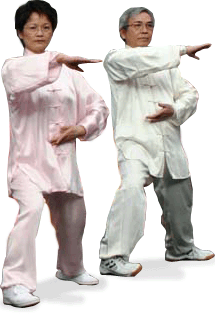 The method of instruction used by Ji Hong Tai Chi is adopted from the “Theory of Systematic Approach to Tai Chi” and “Scientific Training Methods of Tai Chi” by the late Tai Chi Grand Master Ji-Hong Luo who spent more than thirty years researching every possible aspect of Tai Chi. Based on his work, his son and daughter-in-law, Master Luo and Master Gu, further developed and refined this systematic and scientific method of teaching Tai Chi, and created the “Ji Hong Tai Chi System”.
The method of instruction used by Ji Hong Tai Chi is adopted from the “Theory of Systematic Approach to Tai Chi” and “Scientific Training Methods of Tai Chi” by the late Tai Chi Grand Master Ji-Hong Luo who spent more than thirty years researching every possible aspect of Tai Chi. Based on his work, his son and daughter-in-law, Master Luo and Master Gu, further developed and refined this systematic and scientific method of teaching Tai Chi, and created the “Ji Hong Tai Chi System”.
The “Ji Hong Tai Chi System” curriculum includes studying the Tai Chi Principles and applying these principles through Forms, Push Hands and San Shou practice.
Tai Chi Principles
- Basic Tai Chi principles taught at Ji Hong Tai Chi include but are not limited to:
- Yin and Yang: opening and closing; hard (gang) and soft (rou); fast and slow.
- Connecting, relaxing (song), sinking and finding one’s central equilibrium.
- Methods of cultivating internal energy (qi) such as silk reeling exercises;
- Use of the Dantian (elixir field) as the body’s center of gravity and focus of energy cultivation.
- Internal power (nei jin): distinction between external (muscular) power (li) and internal power (jin); power generation as aggregate of body, mind, and internal energy; methods to build, store, move, use and increase the quality of internal power.
- Methods to increase the body’s sensitivity (coordination of body, eye, hands, footwork and energy & mind control).
- The four stages of Tai Chi practice (rid the stiffness to become relaxed; from relaxed to strength; from strength to relaxed; coexistence of relaxed and strength).
Forms
Tai Chi forms are composed of a sequence of rhythmic movements. There are empty-handed forms and weapons forms like Tai Chi sword and broad sword. Practicing forms provides the framework for learning the fundamental Tai Chi principles and cultivating one’s mind and body. At Ji Hong Tai Chi, forms training focuses on:
- Remembering the movements.
- Performing the movements with the requirements of Tai Chi principles.
- Understanding the interdependency of one’s intent (mind), movements (body) and internal energy (qi).
- Correcting and refining the forms, learning martial arts applications hidden in the movements, and developing advanced Tai Chi techniques such as trigger force (fa jin) and mind control.
Push Hands
Tai Chi Push Hands is a two-person exercise that provides for the safe integration of Tai Chi forms and actual martial arts applications. In the “Ji Hong Tai Chi System”, push hands training combines these fixed and moving step techniques from the Chen, Yang and Wu families of Tai Chi:
- Hand and foot techniques (the eight methods and five steps).
- Sensitivity and listening skills such as connecting, joining, sticking, following, and neither letting go nor resisting.
- Footwork focusing on maintaining the body’s equilibrium, weight distribution and power generation.
- Neutralizing an opponent’s incoming force (know one-self and know the opponent).
- Controlling an opponent’s structure and balance (neutralize, control, lock, throw).
San Shou
For motivated students, interested in learning Tai Chi for free-sparring, fighting techniques following Tai Chi principles including grappling, Chin Na (joint locking techniques), kicking, punching, combined with speed, timing, reaction training and further developent of the intensity and quality of one’s jin are also taught under the “Ji Hong Tai Chi System”.

